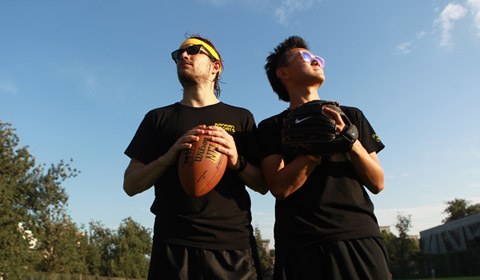Scholar looks at the kung fu-hip hop connection
Updated: 2013-10-24 10:40
By Caroline Berg in New York (China Daily USA)
|
||||||||
New York native Eric Pellerin is a 42nd Street aficionado, but not for the glitz and glamour of Broadway theater. Instead, his interest lies in the grittier "grindhouse" film scene of the 1970s that helped introduce Chinese kung fu cinema to a mainly black and Latino audience.
"I wasn't born until 1975, but I would say that my beginnings in kung fu films were very similar to others, in that Bruce Lee was the beginning," Pellerin told China Daily. "I was breakdancing at the time, and I thought, 'This looks really similar to a lot of the moves in breakdancing.'"
With thousands of these films available on VHS in the 1990s, Pellerin would go to vendors on 42nd Street, such as one of his favorites across from the Port Authority Bus Terminal, who stocked an impressive kung fu selection, if not always the highest quality.
"My friend showed me this film that Lau Kar Leung choreographed and said, 'You have to see this, it's the best thing they have,'" Pellerin recalled. "I said, 'I don't know, Bruce Lee is the best guy ever.' But then I saw that film and I was like, 'Wow, this is really amazing.'"
Lau was a Hong Kong-based Chinese actor, filmmaker, choreographer and martial artist best known for the films he made in the 1970s and 1980s for the Shaw Brothers Studio.
The exposure eventually compelled Pellerin to write a paper on this kung fu master while attending Syracuse University as an undergraduate, which only further spurred his interest in and study of kung fu cinema and its cultural influences.
Today, Pellerin will lead a presentation titled, "Lau Kar Leung in Times Square: film screening and discussion of Executioners from Shaolin," as part of the City University of New York (CUNY) Master of Arts in Liberal Studies (MALS) 2013 lectures and events series. The event is free and open to the public, and will take place at the CUNY Graduate Center from 6:30 pm to 9:30 pm.
"This is one of the quintessential films because it influenced the kung fu genre period," the recent MA recipient said. "It also influenced the Wu Tang Clan and Quentin Tarantino's portrayal of the character Pai Mei - the main villain [in the two-part motion picture Kill Bill]."
Pellerin said he will talk about the influence that both Lau's films in particular and the Chinese kung fu genre in general had on American hip-hop culture. He also said he may give a breakdance or king fu demonstration to keep things lively.
According to his research, Pellerin said American film studios at the time, particularly Warner Brothers, saw an affinity between the kung fu genre and the already popular 42nd Street "Blacksploitation" films targeted at an urban black audience.
"They were stories about non-white heroes - underdog heroes or anti-heroes," said Pellerin, who gave the cocaine dealer Super Fly as an example. "Also, some of those Blacksploitation films featured black heroes doing martial arts, so I think Warner Brothers, being the commercial outfit that they were, saw that there was a connection."
Meanwhile, the hip-hop movement was beginning to take root New York's streets, and the widespread availability of kung fu cinema on 42nd Street and the Black Belt Theater television channel, which premiered in 1981, had an impact on its urban audience.
"Hip-hop is about battling somebody else with your style, similar to kung fu movies, like [Executioners from Shaolin], in which it's Tiger style versus Wu Tang style," Pellerin said. "It was sort of a coincidence that [film studios] were purposefully targeting those movies toward a black-Latino audience, and then the audiences got really into the stories."
Moreover, Pellerin said the choreography and the spectacular feats of the human body in kung fu films resonated with its American audience.
"Those young break dancers, those b-boys, they might not have a lot in terms of wealth or social power, but what they did have was an excellent athletic ability," Pellerin said. "They would go see the films and they would actually replicate certain movements, which not just any average person could do."
carolineberg@chinadailyusa.com
(China Daily USA 10/24/2013 page2)

 Mass. teacher slain; 14-year-old student charged
Mass. teacher slain; 14-year-old student charged
 Driven by smiles
Driven by smiles
 Camp gives sporting chance for students headed overseas
Camp gives sporting chance for students headed overseas
 Chinese protest UK 'fishing' raids
Chinese protest UK 'fishing' raids
 Caretakers in need of counseling
Caretakers in need of counseling Pumpkin fun ahead of Halloween
Pumpkin fun ahead of Halloween
 Weakening Raymond soaks Mexico, no serious damage
Weakening Raymond soaks Mexico, no serious damage Apple unveils new Macs, iPad ahead of holidays
Apple unveils new Macs, iPad ahead of holidays
Most Viewed
Editor's Picks

|

|

|

|

|

|
Today's Top News
Steady growth the goal for GDP
Yale-China partners 100,000 Strong Foundation
China could help rebuild US infrastructure
Atlanta zoo’s cubs named Mei Lun and Mei Huan
Mobile giants talk future in Frisco
Starbucks' pricing furor: tempest in a coffee pot
US-China trade talks a 'turning point'
China and India sign border pact
US Weekly

|

|







